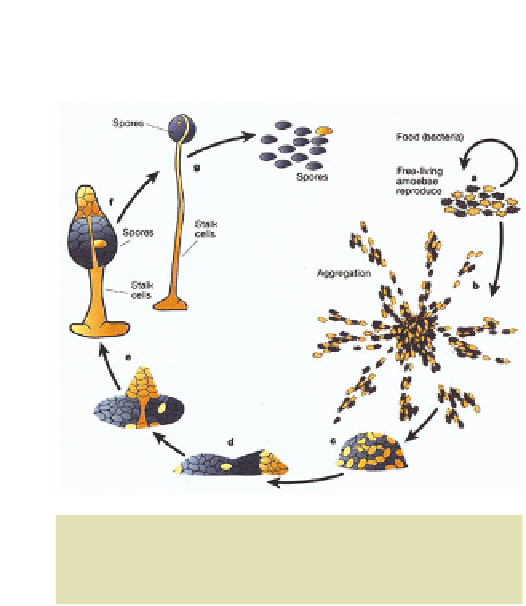Biology Reference
In-Depth Information
One of the best examples of kin discrimination based
on genetic cues comes from a group of organisms
not usually thought of from a social behaviour
perspective - amoebae. Joan Strassmann, Dave Queller
and colleagues investigated the social behaviour of
several species of social amoebae, or slime moulds, in
the group
Dictyostelium
. Individuals of these species
live in the soil, where they feed upon bacteria
(Fig. 114a). However, when starved of food, the cells
aggregate in thousands to form a multicellular,
motile 'slug' (Fig. 11.4d). Slugs migrate to the soil
surface, where they transform into a fruiting body
composed of a stalk structure holding aloft a ball of
spores (Fig. 11.4g). The stalk cells are non-viable,
dying without reproduction after aiding the dispersal
of the spores. Consequently, becoming a stalk cell is an
example of extreme altruism, analogous to the sterile
worker caste in social insects.
Mehdiabadi
et al
. (2006) tested whether kin
discrimination occurred in
Dictyostelium purpureum
,
by mixing the cells of two unrelated lineages on agar
plates, one of which was labelled with a fluorescent dye (Mehdiabadi
et al
., 2006). When
they examined the fruiting bodies that had formed on the plates, they found that cells
preferentially formed slugs and fruiting bodies with members of their own lineage, to
who they are clonally (
r
Fig. 11.4
The life cycle of a slime mould. With
permission of Dr. Mary Wu and Dr. Richard Kessin.
Extreme altruism:
slime mould
stalk cells
Slime mould cells
preferentially
form fruiting
bodies with
relatives
1) related. Overall, this discrimination led to an average
relatedness in fruiting bodies of 0.8, as opposed to the expected value of 0.5 (expected
because
r
=
1 to the other half). Thanks to this high relatedness,
kin selection offers a potential solution to why some cells sacrifice themselves and
become stalk cells - they are helping their relatives disperse. Further work has since
suggested that the underlying genetic cue may come from highly variable
lag
genes,
which are involved in signalling and adhesion between cells (Benabentos
et al
., 2009).
=
0 to half the cells and
r
=
Environmental cues for kin discrimination
The alternative mechanism for recognizing kin is that individuals use a simple rule, for
example 'treat anyone in my home as kin'. Parent birds, for example, may ignore their own
young if they are placed just outside the rim of their nests, yet will readily accept a strange
chick placed inside their nest. This can lead to odd results; for example a reed warbler,
Acrocephalus scirpaceus,
may mob an adult cuckoo,
Cuculus canorus,
which approaches its
nest and then, a minute later, return to the hard work of feeding a baby cuckoo inside its
nest! Usually, however, this simple rule will lead individuals to care for their own offspring.
Another mechanism for recognizing kin is to learn that those you grow up with are
kin. Konrad Lorenz gave the name 'imprinting' to the phenomenon observed in young
geese of following the first conspicuous moving object they see after hatching. Usually
this will be their mother and so result in them following someone who will keep them
warm and protect them. In an experimental situation, however, young birds have been
imprinted on humans and even flashing lights. Experiments by Holmes and Sherman
Simple rules for
recognizing kin





























